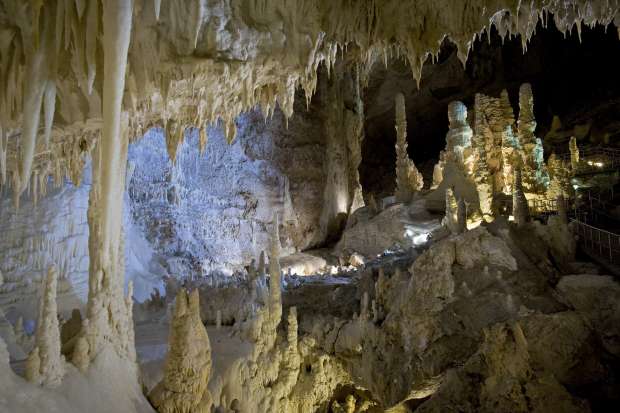In 1971, team of cave scientists exploring the area around the Frasassi Gorge near Ancona, Italy, made one of the most exciting cave discoveries. They came upon an extraordinary labyrinth of underground caverns and walkways that uncoiled for 8 miles (13 km) beneath the Apennine Mountains.
With only dim torchlight to guide them along the passages of the intricate cave system, the team waded knee-deep through still, clear pools and banks of mud, gazing in awe at stalagmites rising like a forest of crystal columns around them. As they ventured deeper into the chilly, dank atmosphere of what proved to be a vast network of caves a fantastic array of giant marble-like pillars and delicate curtains of frosted rock, the work of more than a million years of erosion, began to emerge.
Meandering for almost 2 miles (3.2km) between steep rock walls the Frasassi Gorge was carved by the rapid currents of the river Sentino, a tributary of the Esino, which flows from the Apenines north-east to the Adriatic. The steep limestone walls of the gorge are riddled with cave openings, one of which – Il Santuaria della Grotta, the Sanctuary Cave – houses an 11th century chapel dedicated to Santa Maria del Frasassi and an octagonal church built at the request of Pope Leo XII in 1828. With the discovery of the astonishing subterranean wonderland now known as the Frasassi Caves, this hitherto sleepy corner of Ancona became internationally renowned.
The hills that embrace the gorge are typical of karst landscape. (Karst is the term geologists use to describe limestone terrain modelled by the dissolving action of acidic rainwater). Interlinked sinkholes, disappearing rivers, caves and meandering underground streams are all typical of such landscapes.
The Frasassi complex consists of several cave systems the largest of which is La Grotta Grande del Vento, the Great Cave of the Wind. Public access to this fantasy world follows a smooth path for about 1 mile (1.6km) directly into the limestone hills. A short tunnel bored through the rock provides a spectacular entrance to a cathedral-sized chamber. In the center is the Ancona Abyss, its velvet darkness plunging to as yet unfathomed depths.
Close to this abyss stands Il Gigante, the Giant, an enormous limestone column with a deeply ribbed surface. Facing the Giant is La Cascata del Niagara, the Niagara Falls, a cascading sheet of limestone. Its appearance brings to mind the thunderous roar and ceaseless flow of the mighty falls after which it is named.

The caves are best known for their ethereal beauty and geological significance, but their specialized habitat also supports a variety of fauna. Environmental advantages such as constant temperatures and high humidity, are counterbalanced by the disadvantages of darkness and scarcity of food, but flatworms and millipedes flourish in such conditions, as do blind cave salamanders and crayfish. Bats are the most prolific inhabitants, roosting by day in La Grotta delle Nottole, the Cave of the Bats, and emerging into the night air to feed.
Deeper still in this complex maze of caves lies La Sala delle Candeline, the spectacular Room of the Candles. Here, the floor is strewn with gleaming white stalagmites that emerge from the surface of a shallow pool like glowing candles, encircled at their bases by white ‘cups’, their beauty enhanced by imaginative lighting.

Limestone caves and their formations, such as those of the Frasassi and the spectacular Guilin Caves in China, are created by the effects of water and time. As rain falls, it absorbs a tiny amount of carbon dioxide from air, turning it into dilute carbonic acid which dissolves calcium carbonate, the principal constituent of limestone. As rainwater seeps down through cracks in the rocks, it wears away the limestone, eventually forming sinkholes and shafts. As the water flows into horizontal rock fractures, it creates underground streams and rivers that carve out a network of chambers in the rock. When the water table drops, these caves are left behind. In the caves, fabulous dripstone formations are created by deposits of calcium carbonate, which is contained in the water, dripping from the cave’s ceiling and gradually forming stalactites. Deposits also accumulate where drops splash on the cave’s floor and build slowly upwards into stalagmites.
The Frasassi Caves are a prime example of how nature has created a network of twisting passages and glistening palatial chambers with awesome limestone formations leading to the creation of an enchanted underground realm.



































